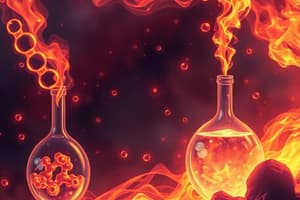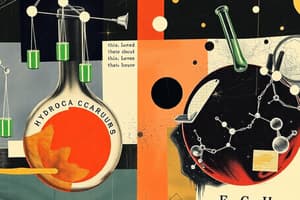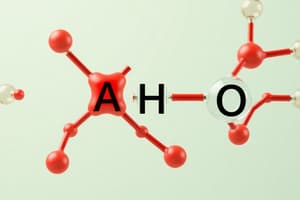Podcast
Questions and Answers
What is the general formula for alkanes?
What is the general formula for alkanes?
CnH2n+2
Which of the following is NOT a characteristic of alkanes?
Which of the following is NOT a characteristic of alkanes?
- They have a general formula of C<sub>n</sub>H<sub>2n</sub>. (correct)
- They are saturated hydrocarbons.
- They are generally unreactive.
- They contain only single bonds.
What is the name of the process used to separate crude oil into different fractions?
What is the name of the process used to separate crude oil into different fractions?
Fractional Distillation
Highly branched alkanes have higher boiling points than less branched alkanes.
Highly branched alkanes have higher boiling points than less branched alkanes.
What is the name of the catalyst commonly used in catalytic cracking?
What is the name of the catalyst commonly used in catalytic cracking?
What does the Research Octane Number (RON) indicate in a fuel?
What does the Research Octane Number (RON) indicate in a fuel?
The double bond in an alkene prevents rotation along the C=C bond axis.
The double bond in an alkene prevents rotation along the C=C bond axis.
What is the name given to the reaction where an electrophile adds to the C=C bond in an alkene?
What is the name given to the reaction where an electrophile adds to the C=C bond in an alkene?
Which of these is a common catalyst used in hydrogenation reactions of alkenes?
Which of these is a common catalyst used in hydrogenation reactions of alkenes?
What is the name of the rule that dictates the position of the hydrogen atom when a hydrogen halide adds to an unsymmetrical alkene?
What is the name of the rule that dictates the position of the hydrogen atom when a hydrogen halide adds to an unsymmetrical alkene?
Cold acidified manganate(VII) is used to oxidize alkenes to alkanediols or glycols.
Cold acidified manganate(VII) is used to oxidize alkenes to alkanediols or glycols.
What is the name given to the reaction of alkenes that produce polymers?
What is the name given to the reaction of alkenes that produce polymers?
What is the name of the catalyst commonly associated with the polymerization of alkenes?
What is the name of the catalyst commonly associated with the polymerization of alkenes?
Aromatic compounds contain the benzene ring functional group.
Aromatic compounds contain the benzene ring functional group.
The C-C bond in benzene is neither a single nor a double bond.
The C-C bond in benzene is neither a single nor a double bond.
What type of reaction does benzene usually undergo with electrophiles?
What type of reaction does benzene usually undergo with electrophiles?
What is the role of a Lewis acid catalyst in the halogenation of benzene?
What is the role of a Lewis acid catalyst in the halogenation of benzene?
Which type of electrophile is involved in the nitration of benzene?
Which type of electrophile is involved in the nitration of benzene?
Sulfonation of benzene is a reversible reaction.
Sulfonation of benzene is a reversible reaction.
What is the role of the AlCl3 catalyst in Friedel-Crafts alkylation?
What is the role of the AlCl3 catalyst in Friedel-Crafts alkylation?
Which electrophile is involved in the Friedel-Crafts acylation reaction of benzene?
Which electrophile is involved in the Friedel-Crafts acylation reaction of benzene?
The addition of hydrogen gas to benzene is a typical reaction that occurs easily at room temperature.
The addition of hydrogen gas to benzene is a typical reaction that occurs easily at room temperature.
Oxidation of benzene occurs easily with oxidizing agents.
Oxidation of benzene occurs easily with oxidizing agents.
What is the product formed when benzene is reacted with a mixture of hydrogen gas and a nickel catalyst at high temperatures?
What is the product formed when benzene is reacted with a mixture of hydrogen gas and a nickel catalyst at high temperatures?
Which of these is NOT a major type of reaction that benzene undergoes?
Which of these is NOT a major type of reaction that benzene undergoes?
Flashcards
Alkane
Alkane
A saturated hydrocarbon containing only C-C and C-H single bonds.
Fractional Distillation
Fractional Distillation
The process of separating components of crude oil based on their boiling points.
Substitution Reaction
Substitution Reaction
A chemical reaction involving the breaking of a bond and the formation of two new bonds.
Addition Reaction
Addition Reaction
Signup and view all the flashcards
Rearrangement Reaction
Rearrangement Reaction
Signup and view all the flashcards
Elimination Reaction
Elimination Reaction
Signup and view all the flashcards
Reaction Mechanism
Reaction Mechanism
Signup and view all the flashcards
Heterolytic Bond Breakage
Heterolytic Bond Breakage
Signup and view all the flashcards
Homolytic Bond Breakage
Homolytic Bond Breakage
Signup and view all the flashcards
Combustion of Alkane
Combustion of Alkane
Signup and view all the flashcards
Halogenation of Alkane
Halogenation of Alkane
Signup and view all the flashcards
Carbocation Rearrangement
Carbocation Rearrangement
Signup and view all the flashcards
Stability
Stability
Signup and view all the flashcards
Constitutional Isomerism
Constitutional Isomerism
Signup and view all the flashcards
Stereoisomerism
Stereoisomerism
Signup and view all the flashcards
Enantiomerism
Enantiomerism
Signup and view all the flashcards
Diastereomerism
Diastereomerism
Signup and view all the flashcards
Chiral Carbon
Chiral Carbon
Signup and view all the flashcards
Chiral Compound
Chiral Compound
Signup and view all the flashcards
Achiral Compound
Achiral Compound
Signup and view all the flashcards
Optically Active Compound
Optically Active Compound
Signup and view all the flashcards
Electrophilic Attack
Electrophilic Attack
Signup and view all the flashcards
Nucleophile
Nucleophile
Signup and view all the flashcards
Catalyst
Catalyst
Signup and view all the flashcards
Cis-Trans Isomerism
Cis-Trans Isomerism
Signup and view all the flashcards
IUPAC Nomenclature
IUPAC Nomenclature
Signup and view all the flashcards
Hydrocarbon Backbone
Hydrocarbon Backbone
Signup and view all the flashcards
Functional Group
Functional Group
Signup and view all the flashcards
Homologous Series
Homologous Series
Signup and view all the flashcards
Atom
Atom
Signup and view all the flashcards
Structural Formula
Structural Formula
Signup and view all the flashcards
Displayed Formula
Displayed Formula
Signup and view all the flashcards
Condensed Formula
Condensed Formula
Signup and view all the flashcards
Skeletal Formula
Skeletal Formula
Signup and view all the flashcards
Study Notes
PRP 1016 Chemistry I
- This course covers Organic Chemistry I, specifically Learning Unit 7.
- The course is prepared by Eswaran Madiahlagan.
- The course is for personal use only and is not for sale.
- It is part of the Centre for Pre-University Studies.
Learning Unit 7.1: Introduction to Organic Chemistry
- Learning Objectives:
- Describe the properties of carbon atoms.
- Differentiate functional groups and classify homologous series.
- Represent organic compounds using various chemical formulas.
- Name organic compounds according to the IUPAC system.
Learning Unit 7.2: Aliphatic Hydrocarbons - Alkanes
- General Information:
- Saturated hydrocarbons containing only C-C and C-H single bonds.
- All C atoms have sp³ hybridization.
- Generally unreactive.
- General formula: CnH2n+2
- Sources of Alkanes:
- Underground deposits of crude oil (petroleum) or natural gas.
- Natural gas (mostly CH₄) requires little purification.
- Crude oil requires separation processes including removal of water, acids, and inorganics followed by fractional distillation.
- Less useful products are converted to useful products via catalytic cracking processes.
Learning Unit 7.3: Aliphatic Hydrocarbons - Alkenes
- General Information:
- Unsaturated organic compound containing the C=C functional group.
- Naming ends with the suffix -ene.
- General formula: CnH2n
- All C atoms in a C=C bond have sp² hybridization.
- The C=C bond has a bond angle of 120°, leading to geometric isomerism.
- The C=C bond is electron-rich and attracts electrophiles.
Learning Unit 7.4: Aromatic Hydrocarbon - Benzene
-
General Information:
- Aromatic compounds contain a benzene ring functional group.
- Aromatics are named from the way they smell (fragrance).
- Benzene and its similar compounds are now referred to as aromatics.
- Each C atom is attached to 1 H atom and 2 other C atoms.
- Each C atom has sp² hybridization.
- The C-C-C bond angle is 120°.
- Each C atom also has 1 unhybridized p orbital.
- The 6 unhybridized p orbitals form a circular π bond.
-
Stability: Benzene is stable and unreactive, unlike alkenes, it does not react easily with electrophilic reagents.
-
IUPAC Nomenclature: Benzene is used as the base name.
- Substituents are named as prefixes.
- Relative positions of substituents are indicated by ortho (1,2), meta (1,3), or para (1,4).
- If a substituent gives a new base name, the substituent is given the 1 position.
- Common names are used for some substituents, such as toluene, phenol, and aniline.
General Information about Organic Reactions
-
Organic Reactions:
- Substitution: Two reactants form two products; an atom or group in the molecule is replaced by a nucleophile, electrophile or free radical.
- Addition: Two reactants form one product, unsaturated reactant becomes saturated product.
- Rearrangement: One reactant forms one product; an atom or group moves from one atom to another.
- Elimination: Saturated reactant becomes unsaturated product; involves the removal of 2 atoms/groups from a molecule, typically from adjacent C atoms.
-
Organic Reagents:
- Electrophiles: Accept an electron pair from organic compounds, attracted to electron-rich regions.
- Nucleophiles: Donate electrons to organic compounds, attracted positively charged regions.
- Radicals: Have unpaired valence electrons, very reactive.
- Oxidizing agents: Compounds that accept electrons and can transfer oxygen.
-
Reactions of Alkanes, Alkenes and Benzene Various reactions and their mechanisms are explained in the videos. Detailed reactions are described, including catalysts and mechanisms.
-
Isomerism: Different compounds with the same molecular formula and different atom arrangements; examples are discussed including constitutional and stereoisomers.
-
Other Concepts:
-
Exercises: Practice problems in identifying and naming various compounds and processes.
Studying That Suits You
Use AI to generate personalized quizzes and flashcards to suit your learning preferences.




